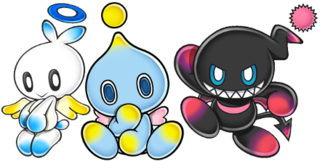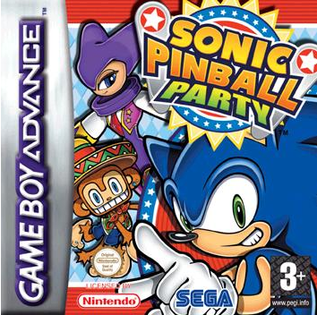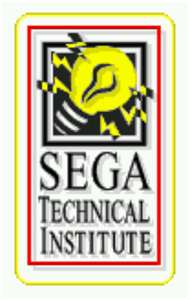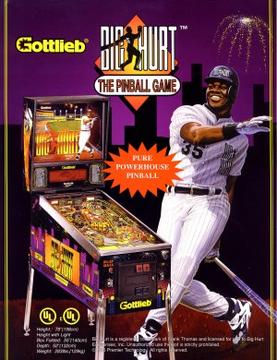
Sonic the Hedgehog is a character created by the Japanese game developers Yuji Naka and Naoto Ohshima. He is the star of the Sonic the Hedgehog franchise and the mascot of the Japanese video game company Sega. Sonic is an anthropomorphic blue hedgehog who can run at supersonic speed. He races through levels, collecting rings and avoiding obstacles, as he seeks to defeat his archenemy, Doctor Eggman. He is accompanied by supporting characters, such as his best friend and sidekick Miles "Tails" Prower, self-proclaimed girlfriend Amy Rose, and friendly rival Knuckles the Echidna.

Chao are fictional life-forms in the Sonic the Hedgehog video game series published by Sega. They are small, childlike creatures that go through a complex life cycle and exist in several visual forms depending on how they are raised. Developer Sonic Team incorporated Chao into the games to encourage players to explore levels and support the good–evil dichotomy of Sonic Adventure 2.

Sonic the Hedgehog is a 1991 platform game developed by Sonic Team and published by Sega for the Genesis/Mega Drive. It was released in North America on June 23 and in PAL regions and Japan the following month. Players control Sonic the Hedgehog, who can run at near supersonic speeds; Sonic sets out on a quest to defeat Dr. Robotnik, a scientist who has imprisoned animals in robots and seeks the powerful Chaos Emeralds. The gameplay involves collecting rings as a form of health, and a simple control scheme, with jumping and attacking controlled by a single button.

Sonic the Hedgehog Spinball, also known as Sonic Spinball, is a 1993 pinball video game developed by Sega Technical Institute and published by Sega. It is a spinoff of the Sonic the Hedgehog series. Players control Sonic the Hedgehog, who must stop Doctor Robotnik from enslaving the population in a giant pinball-like mechanism. The game is set in a series of pinball machine-like environments with Sonic acting as the pinball.
Stern is the name of two different but related arcade gaming companies. Stern Electronics, Inc. manufactured arcade video games and pinball machines from 1977 until 1985, and was best known for Berzerk. Stern Pinball, Inc., founded in 1986 as Data East Pinball, is a manufacturer of pinball machines in North America.

Flicky is a platform game developed by Sega and released as an arcade video game in May 1984. It was licensed to Bally Midway for distribution in the United States. In Flicky, the player controls the eponymous blue bird and must gather all the small birds called Chirps in each round and bring them safely to the exit. There are cat and lizard enemies which can disperse the Chirps and kill the player, but Flicky can use items on the playing field to protect herself and the Chirps from danger.

SegaSonic the Hedgehog is a 1993 arcade game in the Sonic the Hedgehog series by Sega. Controlling Sonic the Hedgehog and his friends Mighty the Armadillo and Ray the Flying Squirrel, the player must escape an island after they are kidnapped by the villain, Doctor Eggman. The game uses an isometric perspective. Players use a trackball to move the characters while dodging obstacles and collecting rings. The game was developed by Sega's arcade division, Sega AM3. It is one of four Sonic games with the SegaSonic name and was inspired by the 1984 game Marble Madness.

Sonic Pinball Party is a video game released for the Game Boy Advance in 2003. It is a celebration of sorts for Sonic Team featuring many references to its previous games, mostly prominently Sonic the Hedgehog, Nights into Dreams, and Samba De Amigo. There was also a release on a Twin Pack cartridge bundled with Sonic Battle and Sonic Advance respectively in 2005.

Sega Technical Institute (STI) was an American video game developer owned by Sega. Founded by the Atari veteran Mark Cerny in 1990, STI sought to combine elite Japanese developers, including the Sonic Team programmer Yuji Naka and his team, with new American talent. STI developed games for Sega Genesis, including several Sonic the Hedgehog games, before it was closed at the end of 1996.

Sonic the Hedgehog 2 is a 1992 platform game developed by Sega Technical Institute (STI) for the Sega Genesis. Players control Sonic as he attempts to stop Doctor Robotnik from stealing the Chaos Emeralds to power his space station. Like the first Sonic the Hedgehog (1991), players traverse side-scrolling levels at high speeds while collecting rings, defeating enemies, and fighting bosses. Sonic 2 introduces Sonic's sidekick Miles "Tails" Prower and features faster gameplay, larger levels, a multiplayer mode, and special stages featuring pre-rendered 3D graphics.

Joypolis is a chain of indoor amusement parks created by Sega and run by CA Sega Joypolis. Beginning on July 20, 1994 with the original location sited in Yokohama, Japan, Joypolis centers have since opened in several cities in Japan and later China. The parks feature arcade games and amusement rides based on Sega's intellectual properties, original themes, and licensed franchises. Alongside the predecessor Galbo venues and the overseas spin-offs SegaWorld London and Sega World Sydney, they were officially referred to under the "Amusement Theme Park" or "ATP" concept by Sega in the 1990s.

Brian L. Schmidt is a music composer for various video games and pinball machines.

Mary Shelley's Frankenstein is a 1995 pinball machine released by Sega Pinball. It is based in the film of the same name.

Sonic's Ultimate Genesis Collection is a compilation of video games developed by Backbone Entertainment and published by Sega for PlayStation 3 and Xbox 360. The compilation features 48 Sega games which were previously released for the Sega Genesis, arcades and the Master System. It is the sequel to the Sega Genesis Collection released previously for the PlayStation 2 and PlayStation Portable, but contains 16 more games.

Zaccaria was an Italian manufacturer of pinball and arcade machines that operated in Bologna from 1974 until 1990. The factory was sold to tecnoplay.

Harley-Davidson is a Sega Pinball pinball machine released in September 1999 and was the last machine released by this company. It was designed by Jon Borg and Lonnie D. Ropp.

Frank Thomas' Big Hurt is a pinball machine designed by Bill Parker and released by Gottlieb in 1995. The game features a baseball theme and is named after Frank Thomas.

Stern Pinball Arcade is a pinball simulation video game developed by FarSight Studios and a spin-off of their earlier title The Pinball Arcade. This game includes recreations of pinball machines manufactured or licensed by Stern Pinball Inc., which also owns the rights to machines from Data East and Sega Pinball.

















